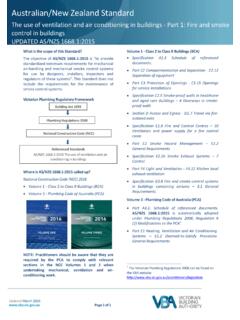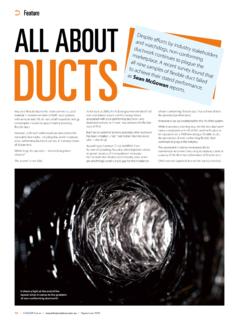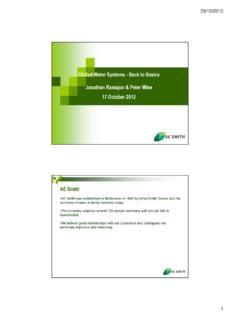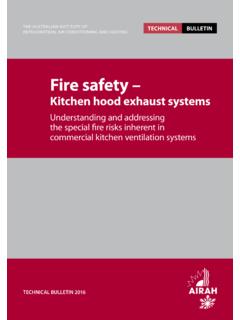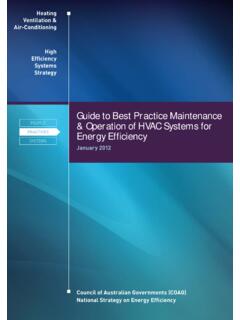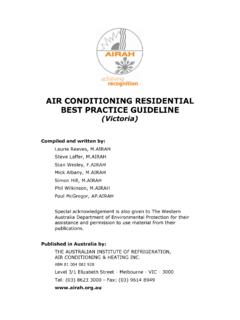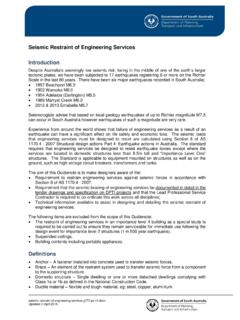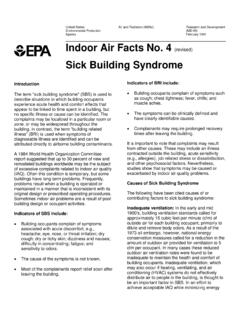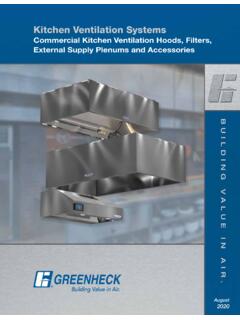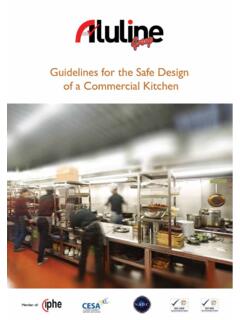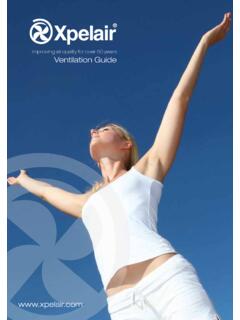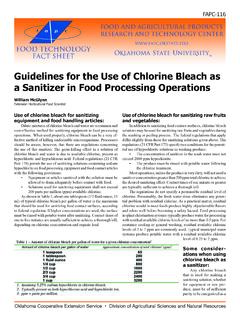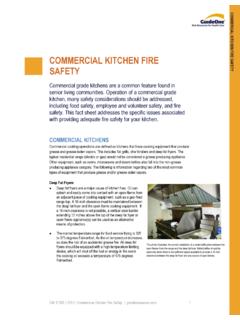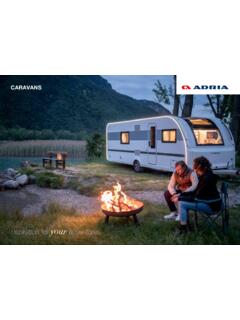Transcription of Implementation of revised AS 1668 Parts 2 & 4 — 2012
1 Implementation of revised AS 1668 Parts 2 & 4 2012 The use of airconditioning and ventilation in buildings Part 2: Mechanical ventilation Part 4: Natural ventilation Topics Overview Why, Where & How of ventilation Part 2 Mech. Vent Principal changes Details & Implications of changes Part 4 Natural Vent Principal changes & Details Overview Q: Why ventilate buildings? A: Amenity, Health and the Law oBuildings protect us from wind, rain, hail & heat, but also shield us from fresh air and capture contaminants oCooking smells & metabolic odours detract from amenity oLaboratories, factories, etc. contaminate with smells & toxins oRespect your neighbour. Exhaust mustn t be a nuisance oConstruction must comply with BCA, esp. Part F4 oAS & AS are both required by Part F4 History of ventilation Standards oResearch on ventilation & perception of indoor air quality by Yaglou, Fanger et al, 1930s to present: Acceptable to 80% of visitors requires L/s/person Acceptable to 95% of visitors requires L/s/person More air required if activity is strenuous More air required for dilution if dust content is high oHigher productivity has recently been linked to 20 L/s per person oAustralian and international Standards were based on Yaglou research except in 1970s oil price shock!
2 Overview Source Publication date or Period Typical rate per person Sydney ventilation Code 1963 & 1971 l/s Common Australian practice 1970s l/s ASHRAE 1972 l/s AS 1976 l/s Ordinance 70 (NSW) 1978 5 l/s AS 1980 l/s [ l/s in some cases] Sydney ventilation Code 1983 l/s AS 1991 10 l/s [ l/s to l/s] AS 2002 10 l/ s [ l/s to l/s] AS 2012 10 l/ s [ l/s to l/s] Sepp nen & Fisk + Bahnfleth 2006 & 2014 20 l/s (Productivity basis) Reductions permitted if particulate filters only or odour + particulate filters are used Overview History of ventilation Standards oAll references to smoking removed oMech. ventilation in Pt. 2 & Natural ventilation in Pt. 4 oDilution Index of 2002 edition removed oO/A rates generally 10 L/s, with option to L/s or L/s oSimpler outdoor air calculations for complex spaces oMore kitchen hood types & cooking processes included oAutomatic demand control ventilation allowed AS 1668 Part 2 - 2012 Principal Changes Changes from the 1991 and 2002 editions oGuidance added on make-up air sources oDistance from inlets to small exhausts relaxed o2002 edition car park exhaust rates used oCar park natural vent.
3 Now in oSmall car park ventilation simpler & matches BCA oJet fans permitted to bend car park airflow oMechanical ventilation of health care now included oBig increase in exhaust from pools and spas AS 1668 Part 2 Principal Changes BCA 2013 & 2014 reference AS 2012 oVentilation of rooms oVentilation of Carparks oLocal exhaust ventilation of Kitchens oAir conditioning & ventilation esp. automatic contaminant control in Carparks BCA 2014 references AS 2012 oNatural ventilation of Carparks AS 1668 Part 2 Principal Changes AS 1668 Part 2 Details & Implications Supply Air oFloor wastes in ducts or plenums MUST always be charged oReliance on condensate only is not appropriate Enclosures prohibiting recycle air, increased to 9: oRooms where odours/noxious gases are produced or outgassed oPet shops, vet centres, kennels, etc.
4 OSwimming pools, decks, etc oEnclosures containing Specific contaminants AS 1668 Part 2 Details & Implications Supply Air Filters oMinimum filter ratings, now based on systems and airflow System characteristics Minimum filter rating (see AS ) 1000 L/s ducted G4 1000 L/s non-ducted G4 <1000 L/s ducted G2 <1000 L/s non-ducted NR Evaporative coolers NR LEGEND: NR = no requirement TABLE MINIMUM FILTER RATING AS 1668 Part 2 Details & Implications Minimum Outdoor Air supply oOutdoor air calculation based on 1991 Standard oConcept of Effective Outdoor Air allows credits for: Air-cleaning systems, Transfer from adjacent spaces, Unused O/A in recycle airstream, Odour & particulate filters oCalculation methods in Appendix D oThese are the minimum values noted in BCA (b)
5 AS 1668 Part 2 - 2012 Plant RoomConference RoomMeeting Room A33% OA25% OAMain Office15% OAAir-handling Unit serving Multiple EnclosuresFirst trial iteration for Outdoor Air flowAir CleanerSecondary Office15% OAOutdoor AirRecycle AirReturn AirSpill AirSupply Air25% OA AS 1668 Part 2 - 2012 Plant RoomConference RoomMeeting Room A33% OA25% OAMain Office15% OAAir-handling Unit serving Multiple Enclosures3rd iteration for Outdoor Air + Transfer AirSecondary Office15% OAAir CleanerOutdoor AirRecycle AirReturn AirSpill AirSupply AirTransfer Air18% OA AS 1668 Part 2 Details & Implications Demand Controlled supply ventilation oAutomatic operation of Outdoor Air Demand Control ventilation using population indicators. Options are: Time-of-day schedules CO2 sensors Mixed gas sensors People counters AS 1668 Part 2 Details & Implications Exhaust Air oSupply air instead of exhaust is permitted where: Discharge is not objectionable, and Adjacent spaces are at higher pressure oFull kitchen Exhaust exempted when only reheating food oBUT AS doesn t cover all exhaust ventilation , refer Appendix O eg: Explosion vents, Spray painting, Fume cupboards and Welding booths AS 1668 Part 2 Details & Implications kitchen Hood Exhaust types oNow 7 different hood types.
6 Additions are: Eyebrow hoods Ventilated ceilings Proprietary equipment oAnd 7 different cooking process types . Additions are: Oriental cooking tables and woks Bread ovens & steam-producing Combi oven Courtesy of Halton Closed ventilated ceilings envisaged in the Standard, incorporate direct duct connections to supply and exhaust AS 1668 Part 2 Details & Implications AS 1668 Part 2 Details & Implications kitchen Hood Exhaust airflows oEnergy saving feature. Exhaust velocity can be reduced to m/sec for hoods over non-grease-producing items oFurther reduction to m/s if hood volume is increased kitchen Hood Exhaust discharges oConcessions allowed on separation from kitchen Exhaust discharge to Air Intakes if odour filter or photochemical treatment is installed.
7 Calculation methods provided AS 1668 Part 2 Details & Implications Filters & Ozone odour treatment AS 1668 Part 2 Details & Implications Make up of Exhaust Airflow oReflecting Section J Guidance is given on maximum flow of air-conditioned air for kitchen Exhaust make-up air oWarning given on openable windows for make-up of residential exhausts. These may not be suitable sources AS 1668 Part 2 Details & Implications Separation of Exhausts & Air Intakes oExhaust discharges less than 1,000 L/s not required to be 6 metres from air intakes oDischarges less than 200 L/s can be 1 metre from intake oBut, multiple discharges less than 1,000 L/s within a 6 m radius are aggregated as one oPerhaps riser shafts no longer required in apartments?
8 Proximity of exhaust discharges & openable windows AS 1668 Part 2 Details & Implications AS 1668 Part 2 Details & Implications Carpark ventilation oMajor reduction in exhaust airflows, based on 2002 edition Small car parks: * 40 cars, same as BCA * Min airflow: 3,000 down to 2,000 L/s * Per vehicle rate: 500 down to 400 L/s * Area rate: down to L/s per m2 Large car parks: * 20% less flow by calculation * Entering cars not calculated * Extra factors for Vehicle type, Usage & Staff exposure AS 1668 Part 2 Details & Implications Carpark ventilation oMethods for reducing ventilation rates in small carparks simplified, options for automatic control with door switches & motion detectors oHigh/Low level exhaust outlets no longer required o Air moving devices are permitted to avoid extra ductwork where air paths are obstructed within the car park.
9 (Impulse fans or Jet fans) AS 1668 Part 2 Details & Implications Air moving device NOTE: This option allows ventilation of dead ends in car parks. Not to ventilate the whole car park Examples of Air Moving Devices Courtesy of Fantech AS 1668 Part 2 Details & Implications AS 1668 Part 2 Details & Implications Health Care Buildings oChange from the 1991 edition, but generally same as 2002 edition oApplies to: Operating theatres, Sterile Stores, Infectious & Protective isolation rooms, Recovery rooms, Autopsy rooms and Dirty utility rooms oSpecifies: Supply & Recirculation air change rates, Outdoor airflow, Filtration, Exhaust grille location and Room pressure versus adjacent areas Section 5: Health Care Buildings Positive POperating TheatreProtective IsolationPositive PNegative PRecoveryInfectious IsolationNeutral Relative Pressure Diagram - Health Care EnclosuresDirty UtilitySterile StoreAutopsyNegative PPositive PNegative P AS 1668 Part 2 Details & Implications Appendix A Minimum effective outdoor air oDilution Index method of 2002 edition has gone.
10 Same as 1991 edition without smoking oGenerally, all requirements for 15 & 20 L/s per head now reduced to 10 L/s per head Appendix B Minimum exhaust rates oSwimming Pools increased, to 10 L/s per m2 and Spa Exhaust from 5 to 15 L/s per m2 + 15% splash area oDomestic laundry exhaust doubled, to suit clothes dryers AS 1668 Part 2 Details & Implications AS 1668 Part 4 - 2012 The Principal Changes oGenerally includes text from Sections 2 & 3 of the 2002 edition (not in the same order) oCommentary provides pros and cons of natural ventilation oTwo types of natural ventilation are nominated: Simple prescriptive procedure that follows Clauses & of BCA Detailed procedure which refers to Appendix A & B Changes from the 1991 and 2002 editions AS 1668 Part 4 Principal Changes Car Park ventilation oNatural ventilation of car parks included with minimal change from the requirements of the 2002 edition.
